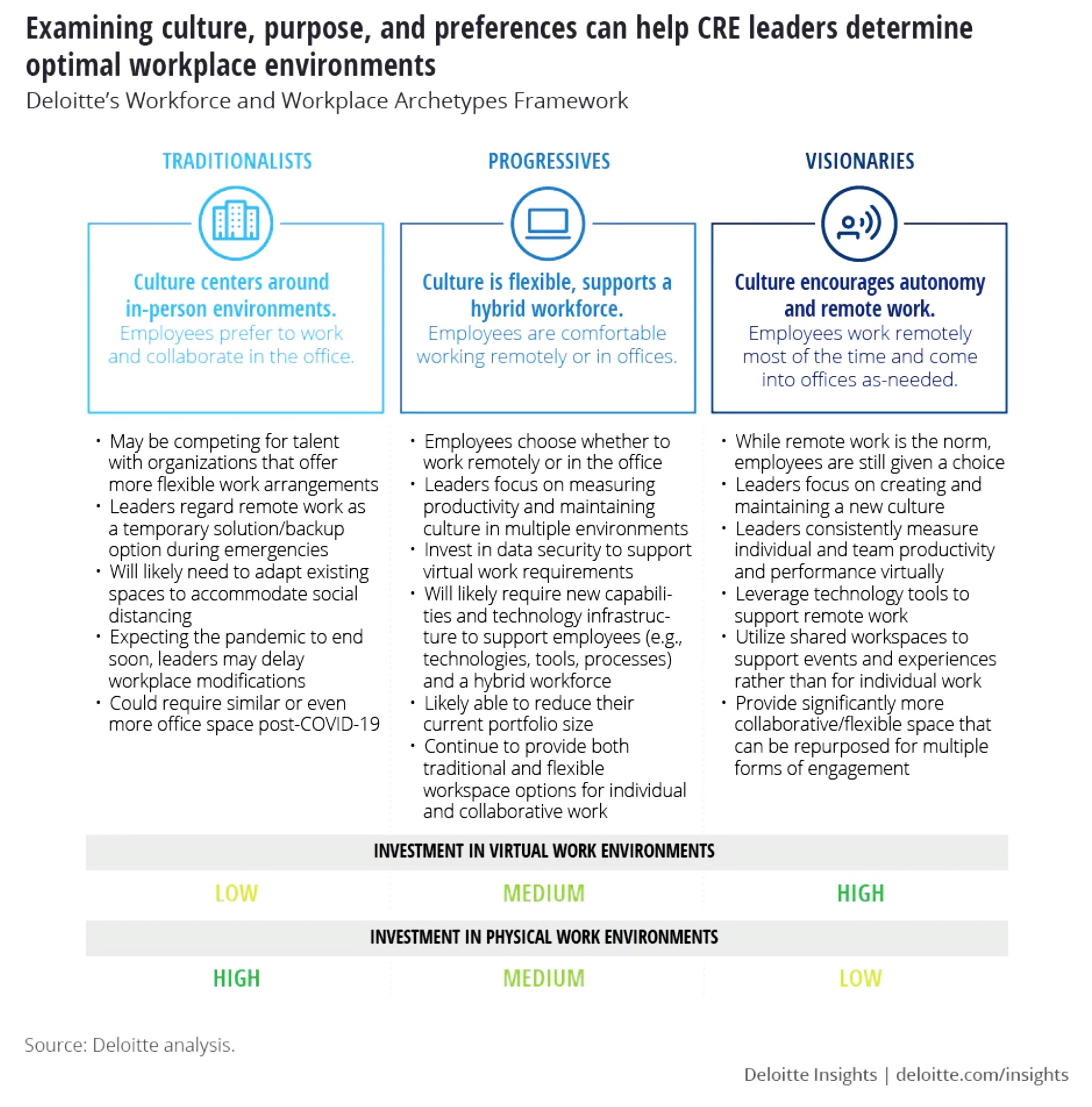Soon after AV equipment and hardware became IP-addressable, manufactures and solution providers added monitoring capabilities to measure everything from projector lamp usage, to room occupancy, and device usage. But it is only in the past few years that some have developed relationships with companies such as Microsoft to analyze information gathered to provide actionable data.
If anyone had been doubting the value of monitoring and analyzing enterprise AV/IT data, the argument in its favor could not be more germane to shaping the health and sustainability of businesses in 2021 and beyond.
Dependent on several variables such as market vertical, vaccine completion, and the economy, reports of the amount of the remote workforce vary widely. One does not need to look much further than what is going on in the commercial real estate (CRE) industry to understand the current volatility.
CRE Barometer
In December 2020, the Deloitte U.S. Center for Financial Services published results of its 2021 Commercial Real Estate (CRE) Outlook. More than 200 industry leaders weighed in on how their companies are recovering from the COVID-19 pandemic.
The following are excerpts from Deloitte’s analysis that most closely align to how AV/IT can impact the future of its businesses through analyzing data.

Leveraging Tenant Data and Analytics: Companies could use different analytical tools to generate insights and facilitate decision making. Now more than ever, CRE companies need to capture and analyze high-frequency data to create a meaningful tenant experience. This could include data around how tenants use different amenities, and/or engagement and performance levels. Companies can analyze tenant engagement levels and behavior to understand preferences and provide a more customized experience. For instance, owners/operators can combine and analyze the occupancy, movement, and temperature sensor data and assist tenants in creating COVID-19-safe seating and space utilization decisions. They can also use tenant data to predict lease renewals and devise appropriate strategies for tenant retention.
Operations: More and more companies are rethinking how and when they use office spaces. Increasingly, offices will be reserved for face-to-face interactions and team-based activities, and enhancing collaboration and innovation, while employees would continue to work remotely for more individualized tasks and assignments. In a 9,100-respondent pulse survey published in The Deloitte Global Millennial Survey 2020, more than 60 percent of respondents say they want the option to work remotely more frequently, even after the pandemic fades. Nearly as many say they would prefer to use videoconferencing instead of traveling for work.
Using Technology to Reposition CRE Space and Facilities Management: With tenants and end users likely to leverage different CRE properties to make emotional in-person connections, spaces are likely to be valued based on the experiential value rather than just traditional metrics such as cost per square foot or sales per square foot. Our survey responses also suggest that unlike the prior emphasis on location, health and safety-related smart building features and occupation density may play a more important role in leasing decisions going forward. Only 38 percent of respondents say their organization has increased collaboration with tenants to understand end-user preferences.
Organizations should use sensing tools, alternative data sets, and analytics to evaluate and predict the impact of changing investor and tenant/end-user preferences on CRE usage and demand. In some instances, companies may have to be creative and adapt spaces for complementary or new purposes.
In most other instances, companies could increase the value of their properties by deploying smart building design and maintenance capabilities and offering more relevant services to tenants and end users. These services include using sensor technologies and predictive analytics to monitor facilities remotely and offer preemptive or usage-driven maintenance activities; or using smart building technologies and 3D visualizations to help landlords assess operational readiness of physical spaces in real time, implement more rigorous cleaning systems, and monitor HVAC systems.
Creating an Enabling Culture: Companies that fall into either the progressive or visionary profiles may have to make higher investments in technologies, tools, and processes to install the appropriate infrastructure for long-term hybrid work. These investments may include productivity and performance measurement tools, training leaders to manage virtual teams, and redesigning spaces to facilitate collaboration and make employees feel safe.
In Their Own Words
We asked experts from leading AV/IT companies to share insights on what challenges can be expected in monitoring a hybrid campus and how the data can help make future decisions about real estate, office planning, employee staffing, and enrollment at universities.
Barco

Lieven Bertier, Workplace Marketing Director
Lots of systems today capture workplace data and provide good insights on meeting room and/or meeting room technology usage. In this way, workplace managers are provided with actionable insights and analytics, and know, for instance, when to expand the number of rooms, or when users are struggling with technology adoption. But in a hybrid environment, the home user is the complicating factor. How do you measure their contribution? How do you make them join the meeting? That’s a key challenge to solve moving forward.
The big challenge for the hybrid workplace will be to find the balance between the in-room participants and remote participants. The keyword here will be engagement. There’s a lot of technology enablement in the workplace, such as whiteboards, whiteboard cameras, UC&C platforms, et cetera, but as shown in our Future of Meetings research, the key question is how to make people engage, and how to make people realize a company’s purpose in their day-to-day hybrid interactions. Giving employees a sense of purpose and belonging will differentiate the winning from losing technologies.
Intel

Brian Cockrell, Intel Unite Solution Product Owner and Co-founder
There are challenges and risks associated with monitoring a hybrid workforce. As it turns out, however, productivity isn’t one of them. The current pandemic forced employers into a grand experiment that has allowed them to see firsthand what many have known for some time: Employees working remotely are at least as productive as those at the office.
Some of the bigger issues with remote work are not related to lack of productivity, but burnout, isolation, and “Zoom fatigue.” Given the growing understanding of these psychosocial costs of 100-percent remote work, and the benefits of in-person collaboration, the need for collaboration spaces will likely increase—not decrease. Workers won’t return to the office building for day-to-day tasks—which can be just as easily tackled remotely—but for the opportunity to come together to engage, interact, and share thoughts and concepts in an environment more suited to social animals.
What this means for businesses is a reorganization of floor plans to provide the spaces for collaboration. This is where usage data from the collaboration platform is invaluable. Knowing which rooms are used, when they are used, the frequency of use, meeting duration, and occupancy can all help optimize occupancy, scaling, and configuration of collaboration spaces. Just as important is monitoring the activities and the use of the various technologies during sessions. This applies to both onsite and remote participants. Collaboration technology is a crucial tool, and usage data could point to underuse of collaboration-enhancing features, or suggest new features and use cases.
Another somewhat novel, but arguably more critical, application of usage information, at least in the near-term, is data-directed hygiene. With a platform like the Intel Unite solution, a combination of sensor data and space management tools can create “heat maps”—helping to guide infection-reduction strategies such as limiting contact in hallways, targeting rooms for cleaning, and monitoring adherence to occupancy restrictions.
Of course, cameras, microphones, digital whiteboards, and other peripherals must be ready to support collaboration. The ability to monitor their health is crucial. The challenge is finding a solution that can manage and self-heal all these varied devices.
Looping back to productivity, collaboration isn’t about maximizing throughput; it’s about generating new ideas and getting unstuck from problems that require more than one mind and perspective. The objectives of monitoring should be to ensure the right mix of collaboration tools and that these tools are ready for use.
Kramer

Matt Kopin, Product Manager
Hybrid environments present new challenges compared to traditional workspaces. Traditionally, there were confirmed numbers of employees or students that would be attending meetings and classes. Today, those numbers are not only reduced, but tend to fluctuate from day to day, or week to week. Data and analytics will be key to determining the trends of in-person meetings and the number of people on campus. This information can be used for scheduling and allocation of the meeting spaces that are available—ensuring that spaces are not overpopulated. Virtual attendees will also need to be a consideration, as there is a cost associated with licenses for videoconferencing software and the necessary network bandwidth required for virtual meetings.
When it comes to data collected from AV equipment on-site, it should be generic and not specific to the user or the user's content. Connection information can be used to determine the number of users in a space and for how long they are using the space. The data does not need to include unique usernames or the content that is presented, but can still provide insight into how the space is being utilized. Automation can also be used to help increase productivity. Meeting rooms can be ready to go before a meeting has started and meeting room calendars can automatically be freed up when meetings end early. For the remote worker, again, data should be generic and not specific to the user. Generic data can still be used to determine how much time users are spending in meetings versus working on their own.
Nureva

Nancy Knowlton, CEO
For some time, manufacturers/developers and managers/users have been considering how data collection from various AV devices and other sensors in meeting spaces can be used. With a return to office seeming like a very real possibility by mid-2021, there are some concrete and valuable uses to which data can be put, such as device availability, device performance, occupancy, and proximity.
All of this data can be delivered to centralized device management systems and alerts triggered by detected out-of-bounds states. Action can be taken from there. But, it’s also important to understand how data can support teams in the room with real-time messages about out-of-bounds conditions so that changes can be made dynamically.
Beyond these obvious needs, there are other concerns for IT managers such as integration of device information. Many systems now provide device monitoring, but it will be less than optimal to manage the data through disparate systems. Aggregating and integrating this data into a single system will be key. While subjective, integrating user feedback input is nonetheless important.
Utelogy

Nicole Corbin, Director of Product and User Experience
The challenge of hybrid campuses is being able to monitor and manage the diverse range of technologies deployed across legacy and new environments, both on site and remotely. These can be mitigated by increasing estate awareness. Deeply understanding your AV estate will allow for the most informed decision making when it comes to future planning for offices as well as employee and student engagement.
One of the largest challenges I see from a hybrid campus is creating a first-class user experience for staff and students alike. People are becoming more accustomed to working and learning from remote platforms. If you have a better user experience at home, why would you want to step foot on a campus? The technology deployed on-site, as well as the facilitators of this technology, need to create a seamless transition from remote to in-person. This seamless transition ensures a consistent first-class user experience—keeping staff and students engaged.
A wide range of helpful data can be captured from monitoring AV and UC devices without compromising privacy. Deploying management platforms such as Utelogy will provide a company with actionable, intelligent data, without storing any private or personal information.
Actionable, intelligent data will help you gain estate awareness—learn which hardware and software gets utilized, see what workspaces get booked most often, and gain a better understanding of meeting attendance and participation via occupancy sensors and audio/video call metrics. Utelogy will also help you gain insights into which devices and at which location(s) trigger the most alerts, so your company can transform from reactive to proactive support.
Being a proactive company will drastically improve productivity as well as employee satisfaction and engagement. Employees will opt to utilize collaboration spaces if they have the confidence that it will be well-equipped, as well as functioning and running smoothly. That first-class user experience should transcend the office to remote workers. Utelogy doesn’t care whether a device lives at home or at the campus; so long as it is connected to the network, data and insights can be gathered and acted upon.

